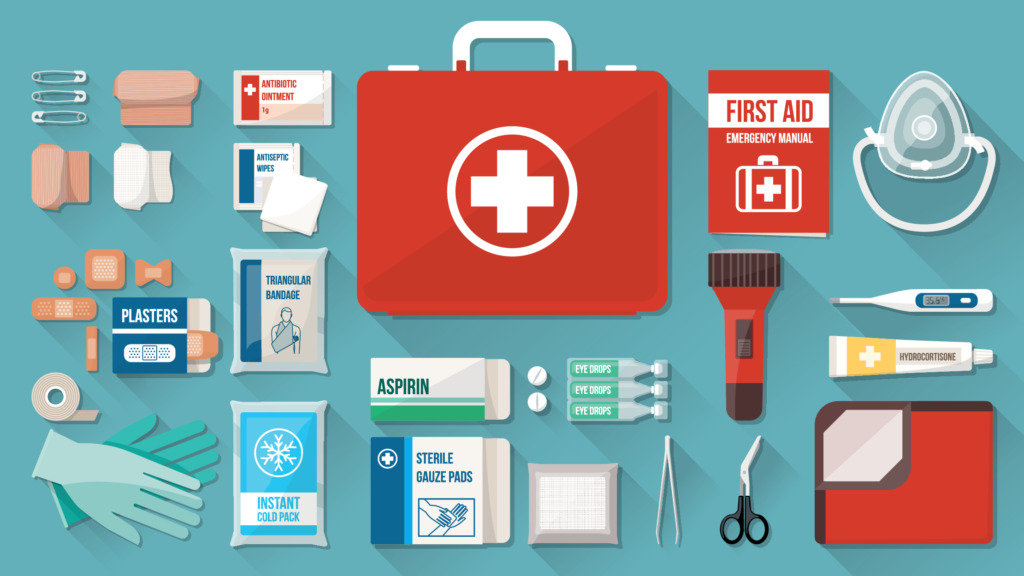Life is full of surprises. You should be prepared to handle the basic injuries that you may encounter in your day to day life. Whether you live alone, or you have a large family, a basic first aid kit is foundational to a successful home safety strategy.
Having a properly stocked first aid kit is critically important. But equally important is understanding when and how to use the items contained within. The skills associated with handling various first aid situations will vary and you should always seek professional medical assistance in emergency situations.
Fumbling around looking for a box of bandages while bleeding, or struggling to remember where the pain relievers are stored in the middle of a crushing headache can be both painful as well as dangerous. A centralized approach to storing first aid supplies allows everyone in the home to know directly where to go in the event of a “minor” accident or medical situation.
What’s in a first aid kit?
Cuts, Scrapes, Minor Wounds
Minor cuts, scrapes, and abrasions can typically be remedied with a variety selection of bandages, gauze, medical tape, antibiotic ointments and hydrogen peroxide or isopropyl alcohol for cleansing the wound. For good measure I also throw in some “moleskin” for protecting blisters and small abrasions from becoming more irritated.
Burns
If you’ve ever had a burn then you know how tremendously painful they can be. The worst part is that the pain just seems to linger. It’s important to have topical burn treatment cream along with your traditional wound treatment items.
Pain/Itch Relief
Typically I try to stock the basics in this category including acetaminophen, ibuprofen, topical pain relievers, and topical itch creams to ease the frustration associated with poisonous plant contact as well as insect bites.
Sprains
Instant ice packs, heat packs, splints, and compression wraps can go a long way in combination with the above pain relievers to easing the pain of a sprain, jammed finger or toe, or even a minor fracture. In the case of a fracture, it goes without saying, you should be seeking immediate medical assistance. Your first aid supplies should only act as a pain mitigation tool while awaiting medical guidance.
Misc.
There are many other items you may or may not keep in your first aid kit depending on your specific situation. I like to keep tweezers for splinter removal, glucose in the event we need to elevate blood sugar levels, antihistamine (Benadryl) for minor allergic reactions, and an anti-diarrheal just to name a few. If you have someone in your family with a history of severe allergic reaction, it might be appropriate to keep an epi-pen as well.
For a more comprehensive list of what we keep in our first aid kit, see our *downloadable first aid pdf.
Where should I keep my first aid kit?
My preference is to keep my first aid kit in a centralized location in my home. For me, I live in a two-story home with a basement, so I keep the first aid kit on the first(main) floor. I stow the first aid kit in a decorative basket with a lid, and everyone knows where to find it. While I keep mine out of public view in my living room, it could easily find a more visible home in a powder room or pantry as well.
Another point worth making is that I also keep a first aid kit in both of my vehicles. While those first aid kits are a slightly pared down version in terms of contents, there is no reason they can’t contain the exact same supplies. I can’t count the number of times I’ve come to rely on that one. Lots of the injuries that occur in my household happen during outdoor activities.
Recommended kits:
While it can take some time and effort, there really is no need for you to pay a premium to have someone else put together a first aid kit for you! Some folks actually find it enjoyable taking the time to accumulate all the items required for a first aid kit and assembling/organizing the kit. This is a great way to become familiar with the individual items, what’s included, and make sure that you understand how and when to use each of them.
Make your own:
Following along with the our *downloadable first aid pdf coming soon, you should be able to source all of the items you need from various retailers both local and online. Keep in mind that this can take some time, and if you’re anything like me, I hate spending time shopping for things that don’t provide me immediate gratification!
If you feel your time is a premium and you’d rather purchase a preassembled first aid kit. While these won’t be as comprehensive as my recommended list, some preparedness is better than none! Here are some kits that we have reviewed and feel confident in recommending.
Where can I learn more about first aid?
While there are a ton of online resources about first aid. I’d recommend sticking with bigger reputable names that you can trust. One medical institution that has a pretty comprehensive listing of first aid situations is the Mayo Clinic in Rochester Minnesota. Take some time to review this first aid resource because there is a ton of valuable information there.
Another option might be to look into some training. Oftentimes communities (especially smaller ones) have volunteer emergency medical staff who sign up to be the first to respond in the event of an accident. Sometimes the training and testing to handle these situations is provided at no charge via the city budget.
Volunteer fire departments often provide much of this training as well to prepare for the medical situations they will encounter. Sometimes they even host public training sessions on topics of critical importance such as CPR.
If you’re interested in training like this, I’d encourage you to reach out to your local municipalities, either your city administrators or your fire departments to see what opportunities might be available.
Final Thoughts:
As a general rule, we all care about our own well being and safety. If you have a family, you already understand that this sense of responsibility and feeling of accountability increases substantially. It’s critical that you are prepared to take care of yourself and your loved ones in the event of an injury. Being prepared can mitigate pain for the injured, reduce recovery time, and potentially save their life in more critical situations.


